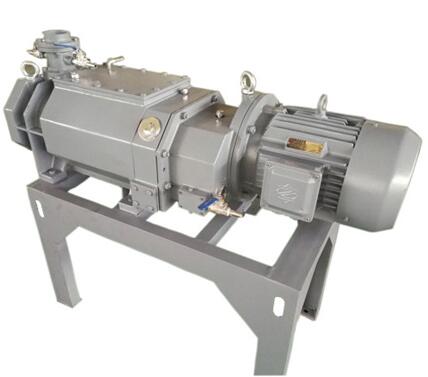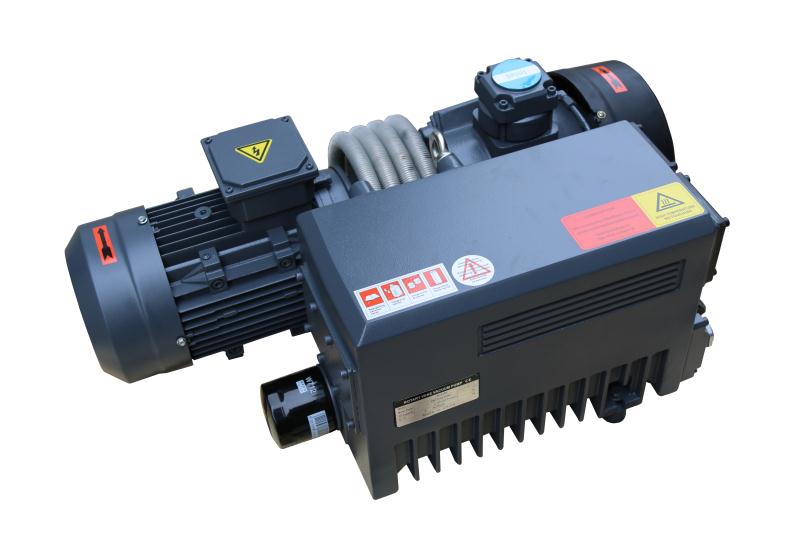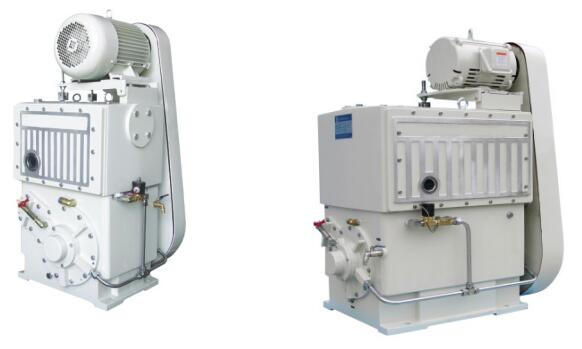Dry vacuum pump and oil sealed vacuum pump
Dry vacuum pump is a mechanical vacuum pump that can start pumping from atmospheric pressure and directly discharge the pumped gas into the atmosphere. There is no oil or other working medium in the pump chamber, and the limit pressure of the pump is the same or close to that of the oil-sealed vacuum pump. There are four kinds of vacuum pumps commonly used in dry mechanical pumps: dry screw vacuum pump, oil-free reciprocating vacuum pump, claw vacuum pump and oil-free scroll vacuum pump.
Dry screw vacuum pump:
LG Series Screw Vacuum Pump
Dry screw vacuum pump is a kind of suction and exhaust equipment which uses a pair of screw to make synchronous high-speed reverse rotation in the pump housing. The two screw are corrected by fine dynamic balance, supported by bearing and installed in the pump housing. There is a certain gap between screw and screw. Therefore, when the pump works, there is no abrasion between them. Rubbing, smooth operation, low noise, working chamber without lubricating oil, therefore, dry screw pump can extract gas containing a large amount of steam and a small amount of dust occasions, higher limit vacuum, lower power consumption, energy saving, maintenance-free advantages. It is an upgrading product of oil seal / water ring / jet vacuum pump.
Oil free reciprocating vacuum pump:
Vacuum pump, also known as piston vacuum pump, relies on the reciprocating motion of piston to make the working volume of pump chamber (cylinder) change periodically. The structure of reciprocating vacuum pump is similar to reciprocating piston compressor. When working, the suction pipe is vacuumed and the exhaust pipe passes through the atmosphere. Reciprocating vacuum pumps can be used in vacuum distillation, vacuum concentration, vacuum crystallization, vacuum filtration, vacuum drying and concrete vacuum operation.
Claw vacuum pump:
Claw vacuum pump is composed of multi-stage rotors. Each stage has two rotors. The two rotors rotate in opposite direction. The suction port is connected with the pump chamber. The volume of the pump chamber becomes larger and the suction ends when the rotor closes the suction port. Then the pump chamber becomes smaller and the compressed gas is compressed. When the exhaust port opens, the pump chamber exhausts and the exhaust port closes. Exhaust is finished, so circulate.
Oil-free scroll vacuum pump:
The scroll disc of a scroll oil-free vacuum pump is a scroll structure formed by one or more involute spirals connected with a plane at one end. A pair of whirlpool pairs consisting of a static whirlpool and a moving whirlpool constitute the basic pumping mechanism of the whirlpool oil-free vacuum. For example, in a two-stage scroll oil-free vacuum pump, there are two fixed scroll discs corresponding to two directions, and one rotating scroll disc located between the two scroll discs. The relative motion of the dynamic and static scroll forms a crescent-shaped vacuum chamber with constantly changing volume, which enables the air to be sucked in from the exhaust port, discharged from the exhaust port and completed the exhaust cycle.
Oil-sealed vacuum pump is a mechanical vacuum pump that uses oil to keep the sealing of moving parts and to realize pumping by changing the volume of pump chamber. The working principle is to increase and shrink the volume of the chamber. When the volume of the working chamber in the pump chamber becomes minimum, it is connected with the inlet pipe of the pump, and the gas enters the pump suction chamber until the volume of the suction chamber is maximum and is separated from the intake. When the volume decreases, the gas is compressed until the pressure of the gas is greater than one atmospheric pressure, and the exhaust valve is opened to discharge the gas. Oil sealed mechanical vacuum pumps can be divided into three types according to their structural types: stator type, rotary type and slide valve type. They all use vacuum pump oil to lubricate, seal and cool; they all rely on the motion of the rotor in the pump housing to periodically change the volume between the rotor, blade and pump housing, in order to achieve the purpose of pumping and exhausting.
Fixed film vacuum pump:
Its structure is simple, its service life is long, and its maintenance is easy. The limit vacuum of the two-stage pump can reach 10-3 Torr, but the pumping speed is small and its application is rare.
Rotary vane vacuum pump:
SV Rotary Vane Vacuum Pump
Single-stage rotary vane vacuum pump (consisting of stator, rotor, etc., with only one studio) and double-stage rotary vane vacuum pump (consisting of two studios, two chambers in series, rotating in the same direction and at the same speed, the first chamber is the front stage of the second chamber).
Piston Vacumm Pump:
Mainly by the pump body and internal eccentric rotation of the sliding valve components, semi-circular sliding valve guide, exhaust valve, shaft and other components.
Piston Vacumm Pump
Whether oil-sealed vacuum pump or dry vacuum pump, in the process of extracting condensable gas, once the pressure of the extracted gas exceeds the saturated vapor pressure of the gas at that time, condensable gas will appear. Because of the existence of lubricating oil in the pump chamber, when condensable gas condenses, the condensable liquefied gas will pollute the pump oil on the one hand, and over time it will emulsify the pump oil to lose its lubrication protection; on the other hand, the condensated gas will re-steam when it returns to the low-pressure end. The vacuum performance and pumping efficiency of the vacuum pump are reduced. Gas town is designed to solve the phenomenon of oil sealed vacuum pump.
The working principle of oil-sealed vacuum pump is relatively simple, that is, when the partial pressure of condensable gas exceeds the saturated vapor pressure of the gas and the overall pressure in the pump chamber does not reach the exhaust pressure, the dry permanent gas is filled through the gas pressure in time, so that the overall pressure in the pump chamber can reach the exhaust pressure ahead of time, discharge and then stop. Condensable gas condenses. In the process of discharging, the permanent gas will also be discharged along with the gas in the original pump chamber.
The above is the role of gas in the oil sealed vacuum pump. But even if there are gas towers, oil-sealed vacuum pumps are only suitable for the medium environment to extract a certain amount of condensable gas. Once a large number of them appear, the efficiency can not be guaranteed. The phenomenon of gas condensation may also occur in dry vacuum pumps, but because there is no pump oil in dry vacuum pumps, the performance of condensable gas extraction is better than that of all kinds of oil-sealed vacuum pumps.
If you want to know more about our vacuum pump products, or if you want to consult the vacuum pump please leave a message or send us an email at contact@evpvacuum.com
(The article comes from the Internet. If reprinting is not allowed, please contact our company to delete it.)



